
Duan Jianjun records paper-cutting patterns in an old residence in Horinger County, north China's Inner Mongolia Autonomous Region, March 15, 2024. The Horinger paper-cutting has formed a unique artistic style with rich patterns demonstrating animals, plants and folk customs, which is closely related to the geographical location of Horinger County, a place boasts a long history of both farming civilization and nomadic civilization. The craft was included in the national intangible cultural heritage list in 2008.
Duan Jianjun, 51, is a national representative inheritor of Horinger paper-cutting. Since 1994, Duan has been engaged in the protection work of Horinger paper-cutting techniques by collecting dictations from elderly people to record paper-cutting instructions and patterns. His work has brought many endangered skills and a large number of precious patterns back to life.
In recent years, with the support of local authorities, Duan established an institute for the sake of popularizing Horinger paper-cutting. He has also set up paper-cutting courses in schools to attract young people's attention. "Paper-cutting is an art coming from our life, and it would be better passed on by serving people," Duan said.(Xinhua/Bei He)
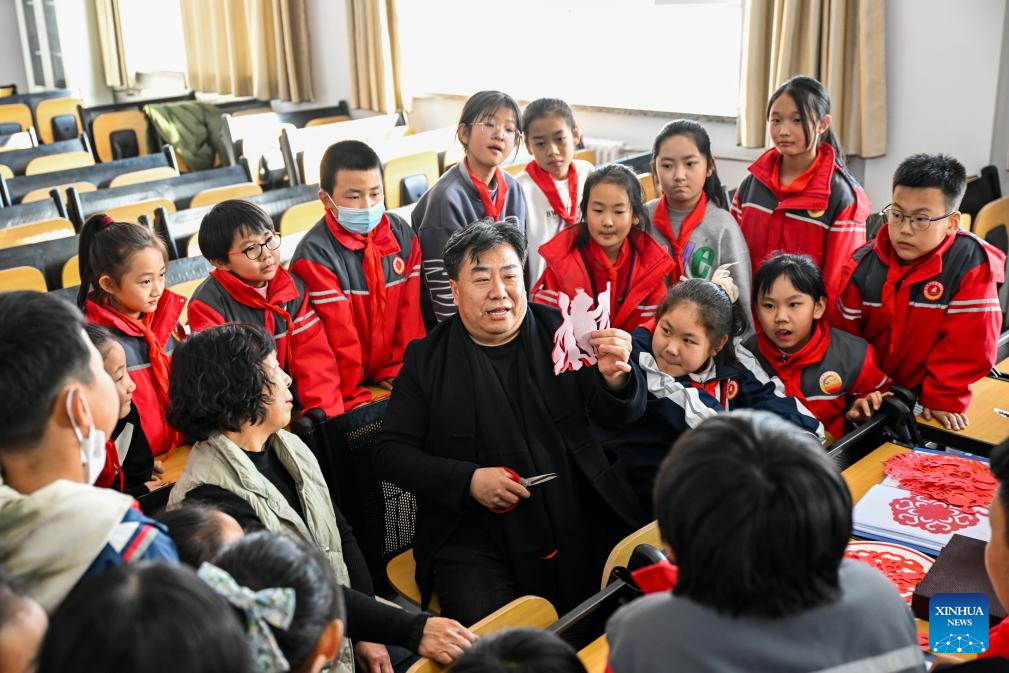
Duan Jianjun (C) teaches students paper-cutting skills at Horinger No. 2 Primary School in Horinger County, north China's Inner Mongolia Autonomous Region, March 14, 2024. The Horinger paper-cutting has formed a unique artistic style with rich patterns demonstrating animals, plants and folk customs, which is closely related to the geographical location of Horinger County, a place boasts a long history of both farming civilization and nomadic civilization. The craft was included in the national intangible cultural heritage list in 2008.(Xinhua/Li Zhipeng)
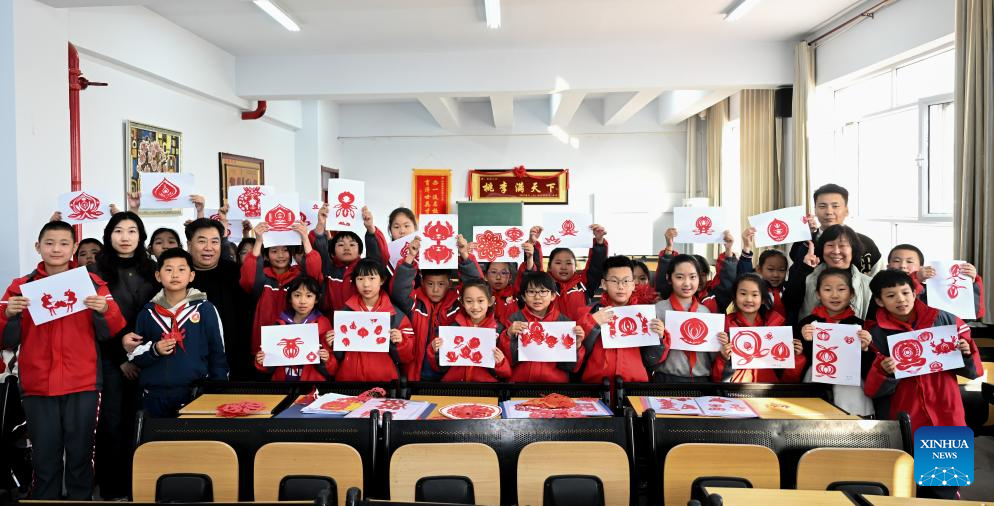
Duan Jianjun (4th L, front) poses for a group photo with students of Horinger No. 2 Primary School in Horinger County, north China's Inner Mongolia Autonomous Region, March 14, 2024. The Horinger paper-cutting has formed a unique artistic style with rich patterns demonstrating animals, plants and folk customs, which is closely related to the geographical location of Horinger County, a place boasts a long history of both farming civilization and nomadic civilization. The craft was included in the national intangible cultural heritage list in 2008.(Xinhua/Bei He)

Duan Jianjun (R) and his apprentice Niu Chunxia discuss paper-cutting skills at his institute in Horinger County, north China's Inner Mongolia Autonomous Region, March 14, 2024. The Horinger paper-cutting has formed a unique artistic style with rich patterns demonstrating animals, plants and folk customs, which is closely related to the geographical location of Horinger County, a place boasts a long history of both farming civilization and nomadic civilization. The craft was included in the national intangible cultural heritage list in 2008.(Xinhua/Bei He)

Duan Jianjun makes paper-cutting works at home in Horinger County, north China's Inner Mongolia Autonomous Region, March 14, 2024. The Horinger paper-cutting has formed a unique artistic style with rich patterns demonstrating animals, plants and folk customs, which is closely related to the geographical location of Horinger County, a place boasts a long history of both farming civilization and nomadic civilization. The craft was included in the national intangible cultural heritage list in 2008.(Xinhua/Bei He)
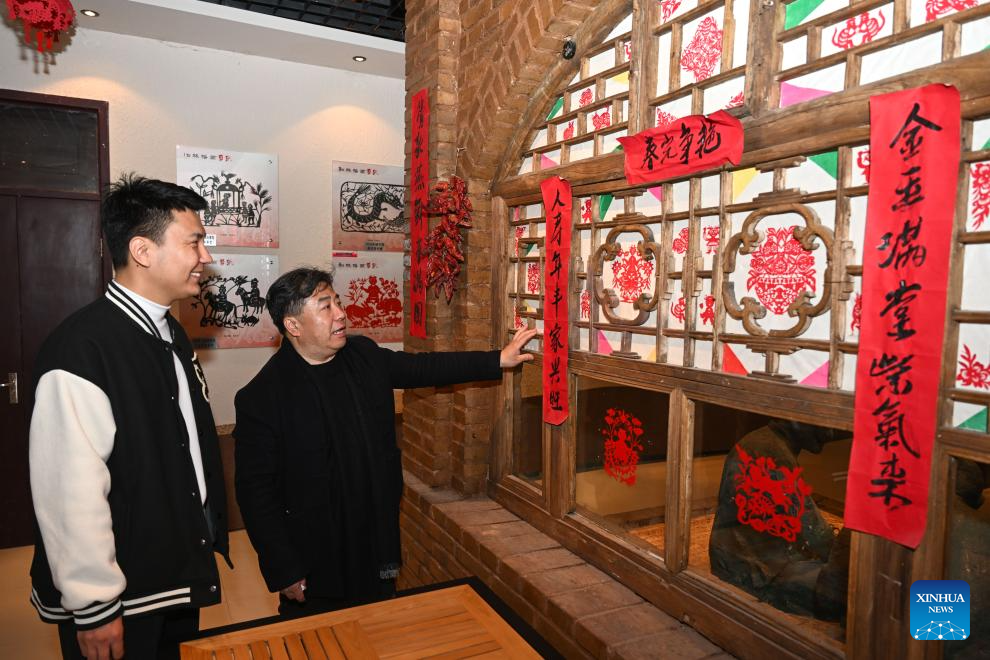
Duan Jianjun (R) and his apprentice Bao Zhiming view paper-cutting works at an exhibition hall in Horinger County, north China's Inner Mongolia Autonomous Region, March 14, 2024. The Horinger paper-cutting has formed a unique artistic style with rich patterns demonstrating animals, plants and folk customs, which is closely related to the geographical location of Horinger County, a place boasts a long history of both farming civilization and nomadic civilization. The craft was included in the national intangible cultural heritage list in 2008.(Xinhua/Bei He)

Duan Jianjun makes paper-cutting works at home in Horinger County, north China's Inner Mongolia Autonomous Region, March 14, 2024. The Horinger paper-cutting has formed a unique artistic style with rich patterns demonstrating animals, plants and folk customs, which is closely related to the geographical location of Horinger County, a place boasts a long history of both farming civilization and nomadic civilization. The craft was included in the national intangible cultural heritage list in 2008.(Xinhua/Bei He)

Paper-cutting works are pictured in an old residence in Horinger County, north China's Inner Mongolia Autonomous Region, March 15, 2024. The Horinger paper-cutting has formed a unique artistic style with rich patterns demonstrating animals, plants and folk customs, which is closely related to the geographical location of Horinger County, a place boasts a long history of both farming civilization and nomadic civilization. The craft was included in the national intangible cultural heritage list in 2008.(Xinhua/Bei He)
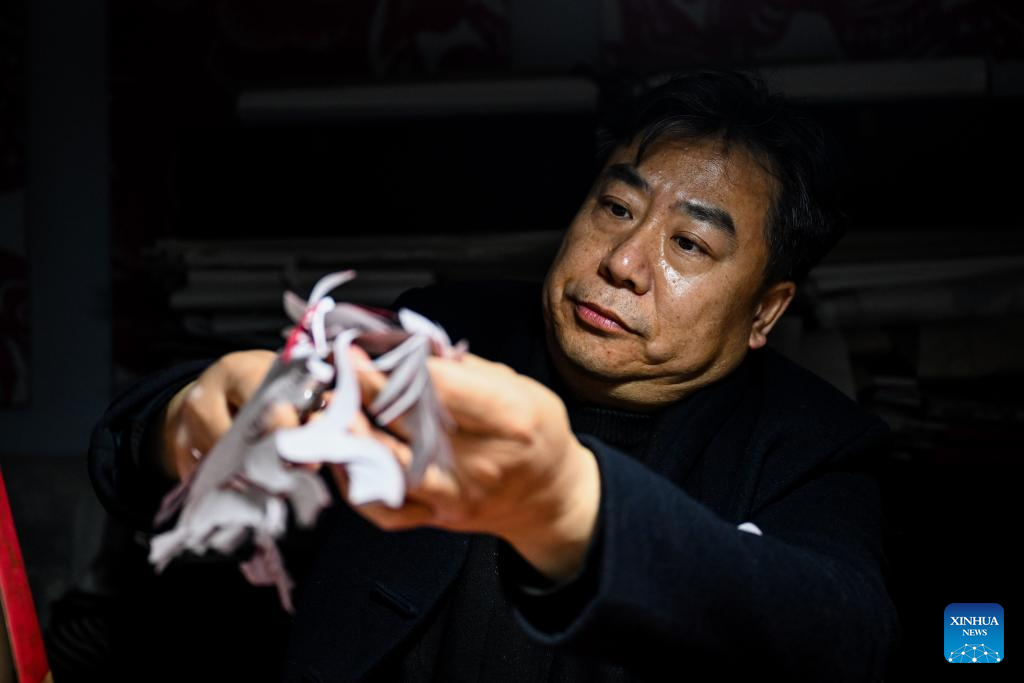
Duan Jianjun makes paper-cutting works at home in Horinger County, north China's Inner Mongolia Autonomous Region, March 14, 2024. The Horinger paper-cutting has formed a unique artistic style with rich patterns demonstrating animals, plants and folk customs, which is closely related to the geographical location of Horinger County, a place boasts a long history of both farming civilization and nomadic civilization. The craft was included in the national intangible cultural heritage list in 2008.(Xinhua/Li Zhipeng)
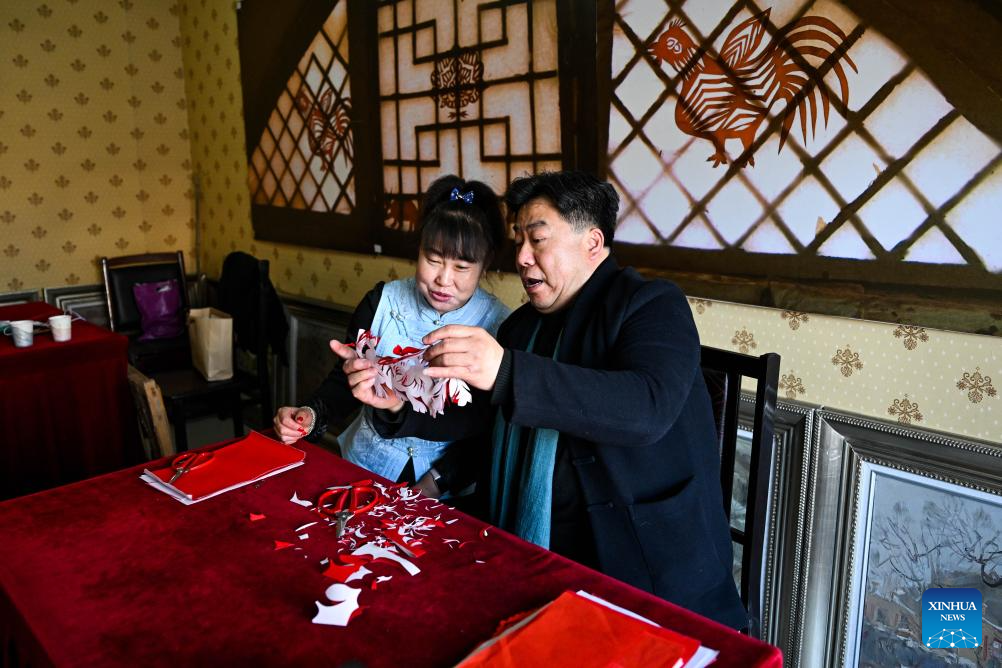
Duan Jianjun (R) and his apprentice Niu Chunxia discuss paper-cutting skills at his institute in Horinger County, north China's Inner Mongolia Autonomous Region, March 14, 2024. The Horinger paper-cutting has formed a unique artistic style with rich patterns demonstrating animals, plants and folk customs, which is closely related to the geographical location of Horinger County, a place boasts a long history of both farming civilization and nomadic civilization. The craft was included in the national intangible cultural heritage list in 2008.(Xinhua/Liang Wanshan)
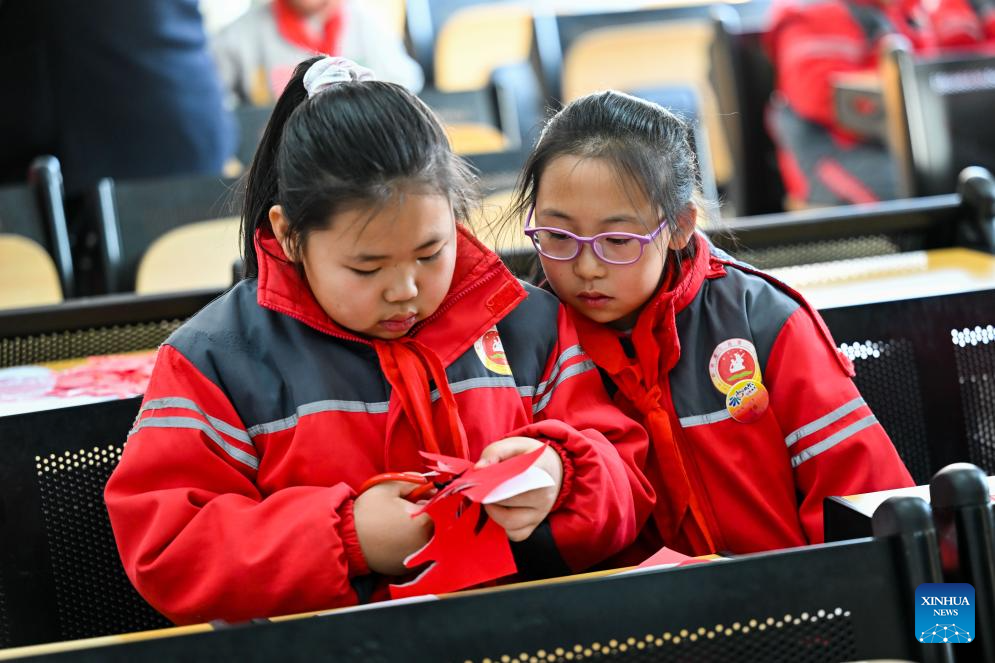
Students makes paper-cutting works at Horinger No. 2 Primary School in Horinger County, north China's Inner Mongolia Autonomous Region, March 14, 2024. The Horinger paper-cutting has formed a unique artistic style with rich patterns demonstrating animals, plants and folk customs, which is closely related to the geographical location of Horinger County, a place boasts a long history of both farming civilization and nomadic civilization. The craft was included in the national intangible cultural heritage list in 2008.(Xinhua/Li Zhipeng)
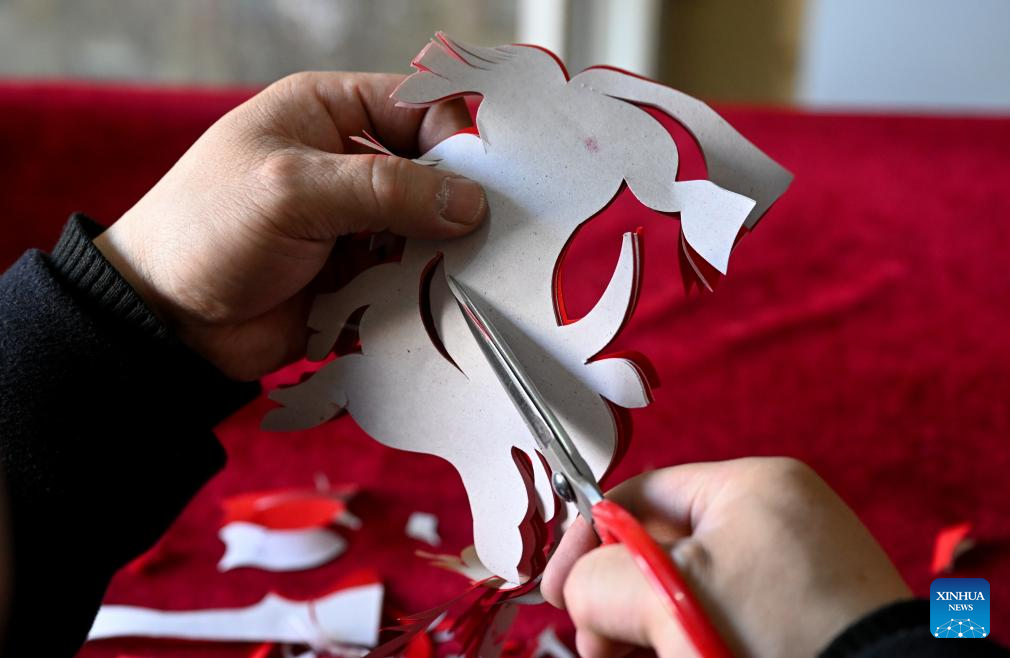
Duan Jianjun makes paper-cutting works at his institute in Horinger County, north China's Inner Mongolia Autonomous Region, March 14, 2024. The Horinger paper-cutting has formed a unique artistic style with rich patterns demonstrating animals, plants and folk customs, which is closely related to the geographical location of Horinger County, a place boasts a long history of both farming civilization and nomadic civilization. The craft was included in the national intangible cultural heritage list in 2008.(Xinhua/Bei He)
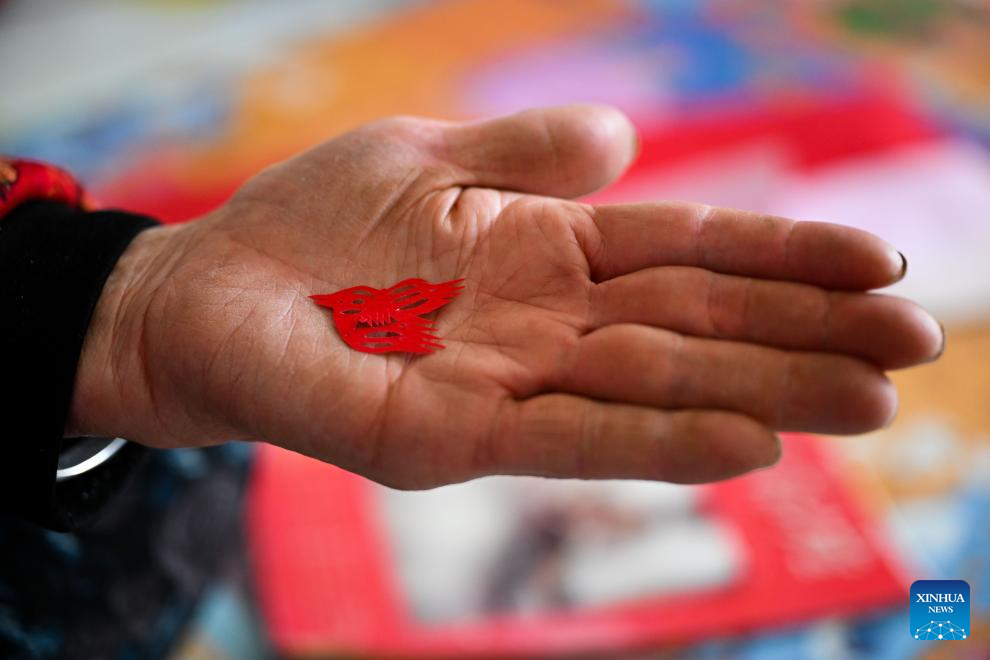
An elderly woman shows her paper-cutting work in Horinger County, north China's Inner Mongolia Autonomous Region, March 15, 2024. The Horinger paper-cutting has formed a unique artistic style with rich patterns demonstrating animals, plants and folk customs, which is closely related to the geographical location of Horinger County, a place boasts a long history of both farming civilization and nomadic civilization. The craft was included in the national intangible cultural heritage list in 2008.(Xinhua/Li Zhipeng)
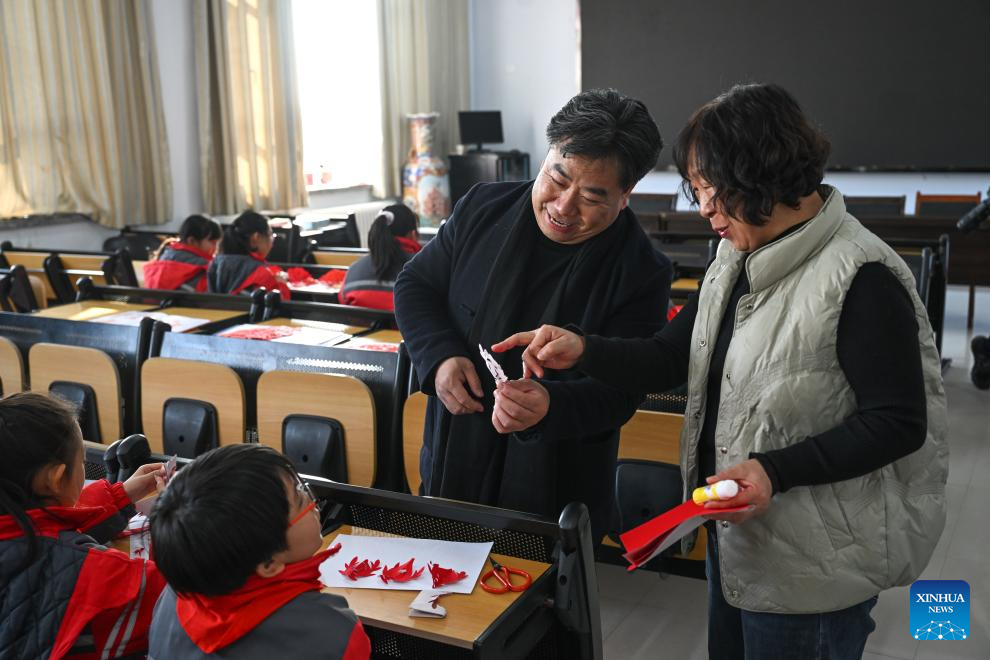
Duan Jianjun (2nd R) communicates with art teacher Xu Feng (1st R) at Horinger No. 2 Primary School in Horinger County, north China's Inner Mongolia Autonomous Region, March 14, 2024. The Horinger paper-cutting has formed a unique artistic style with rich patterns demonstrating animals, plants and folk customs, which is closely related to the geographical location of Horinger County, a place boasts a long history of both farming civilization and nomadic civilization. The craft was included in the national intangible cultural heritage list in 2008.(Xinhua/Liang Wanshan)
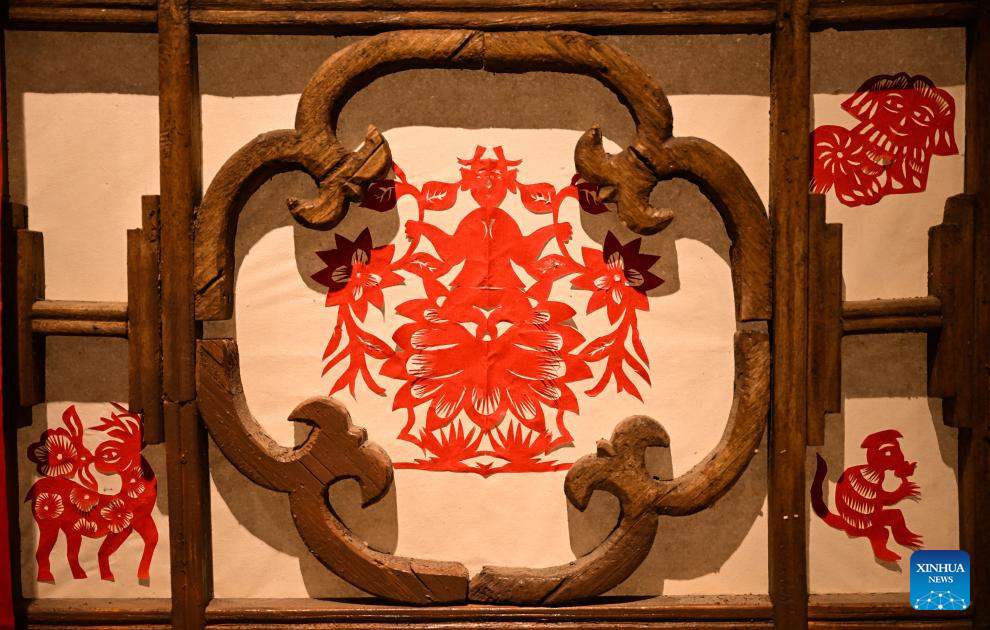
Paper-cutting works are displayed at an exhibition hall in Horinger County, north China's Inner Mongolia Autonomous Region, March 14, 2024. The Horinger paper-cutting has formed a unique artistic style with rich patterns demonstrating animals, plants and folk customs, which is closely related to the geographical location of Horinger County, a place boasts a long history of both farming civilization and nomadic civilization. The craft was included in the national intangible cultural heritage list in 2008.(Xinhua/Liang Wanshan)

Duan Jianjun (C) teaches students paper-cutting skills at Horinger No. 2 Primary School in Horinger County, north China's Inner Mongolia Autonomous Region, March 14, 2024. The Horinger paper-cutting has formed a unique artistic style with rich patterns demonstrating animals, plants and folk customs, which is closely related to the geographical location of Horinger County, a place boasts a long history of both farming civilization and nomadic civilization. The craft was included in the national intangible cultural heritage list in 2008.(Xinhua/Li Zhipeng)
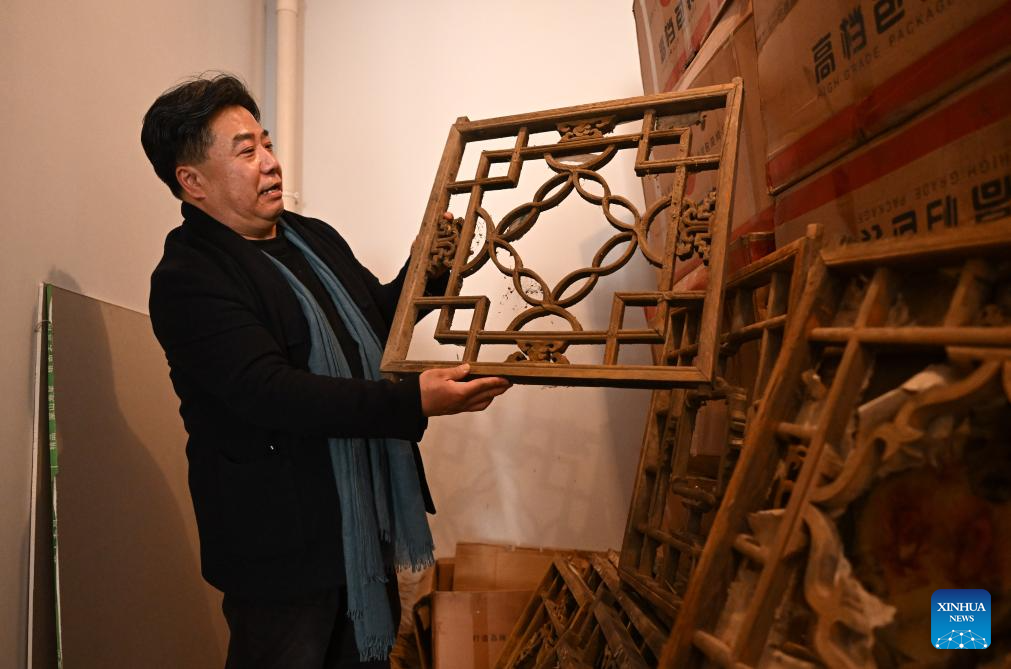
Duan Jianjun checks an ancient window sash component at his institute in Horinger County, north China's Inner Mongolia Autonomous Region, March 14, 2024. The Horinger paper-cutting has formed a unique artistic style with rich patterns demonstrating animals, plants and folk customs, which is closely related to the geographical location of Horinger County, a place boasts a long history of both farming civilization and nomadic civilization. The craft was included in the national intangible cultural heritage list in 2008.(Xinhua/Bei He)
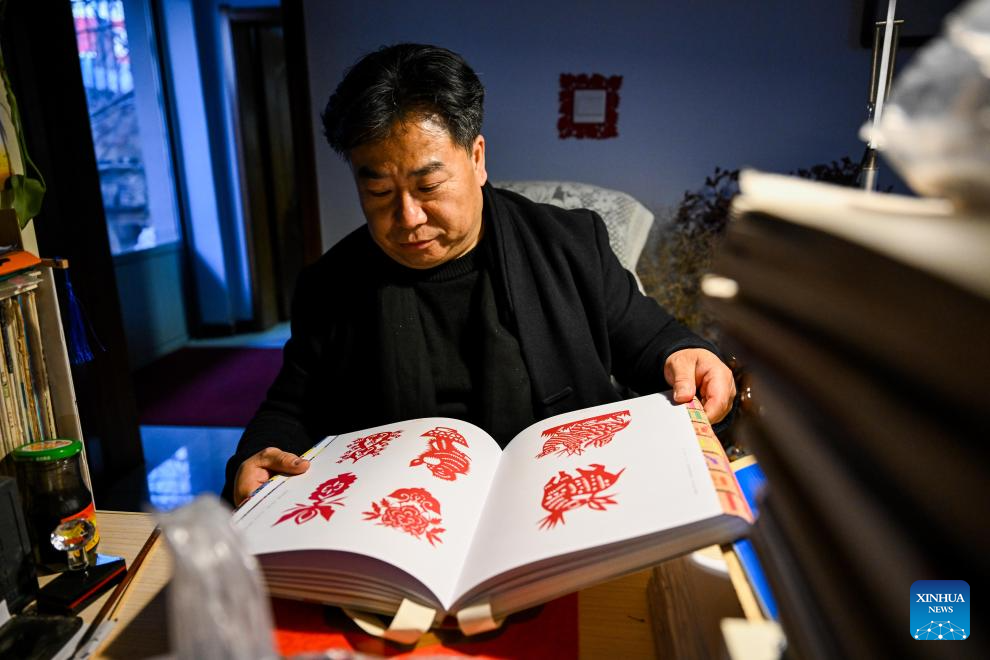
Duan Jianjun reads a book about paper-cutting at home in Horinger County, north China's Inner Mongolia Autonomous Region, March 14, 2024. The Horinger paper-cutting has formed a unique artistic style with rich patterns demonstrating animals, plants and folk customs, which is closely related to the geographical location of Horinger County, a place boasts a long history of both farming civilization and nomadic civilization. The craft was included in the national intangible cultural heritage list in 2008.(Xinhua/Li Zhipeng)

Duan Jianjun (R) and his apprentice Bao Zhiming view a paper-cutting work at an exhibition hall in Horinger County, north China's Inner Mongolia Autonomous Region, March 14, 2024. The Horinger paper-cutting has formed a unique artistic style with rich patterns demonstrating animals, plants and folk customs, which is closely related to the geographical location of Horinger County, a place boasts a long history of both farming civilization and nomadic civilization. The craft was included in the national intangible cultural heritage list in 2008.(Xinhua/Li Zhipeng)
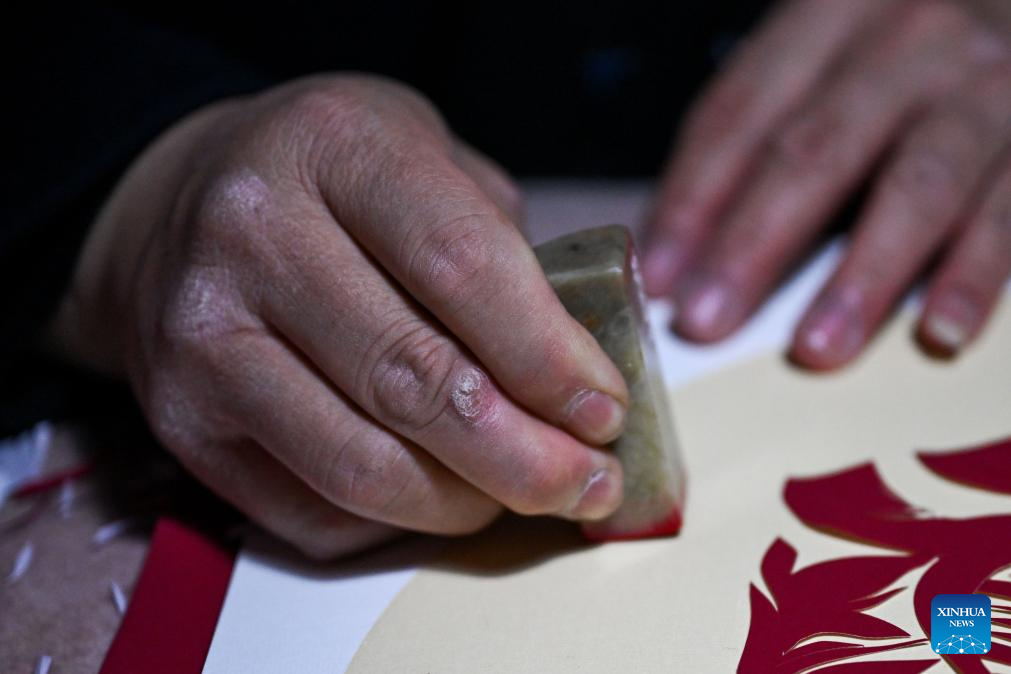
Duan Jianjun seals his paper-cutting work at home in Horinger County, north China's Inner Mongolia Autonomous Region, March 14, 2024. The Horinger paper-cutting has formed a unique artistic style with rich patterns demonstrating animals, plants and folk customs, which is closely related to the geographical location of Horinger County, a place boasts a long history of both farming civilization and nomadic civilization. The craft was included in the national intangible cultural heritage list in 2008.(Xinhua/Li Zhipeng)
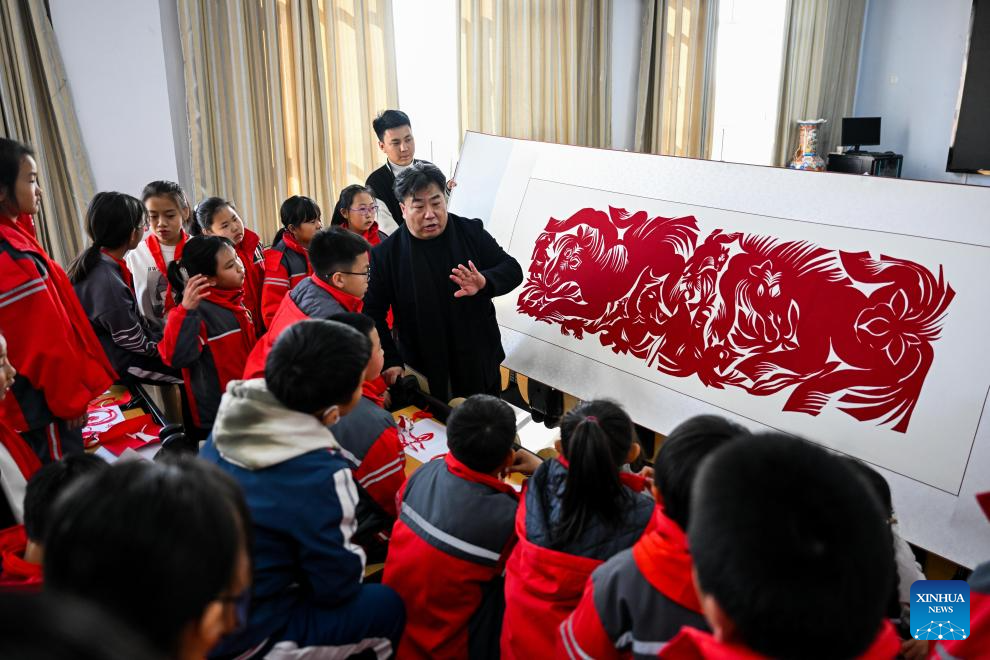
Duan Jianjun (C) introduces his paper-cutting work to students at Horinger No. 2 Primary School in Horinger County, north China's Inner Mongolia Autonomous Region, March 14, 2024. The Horinger paper-cutting has formed a unique artistic style with rich patterns demonstrating animals, plants and folk customs, which is closely related to the geographical location of Horinger County, a place boasts a long history of both farming civilization and nomadic civilization. The craft was included in the national intangible cultural heritage list in 2008.(Xinhua/Li Zhipeng)
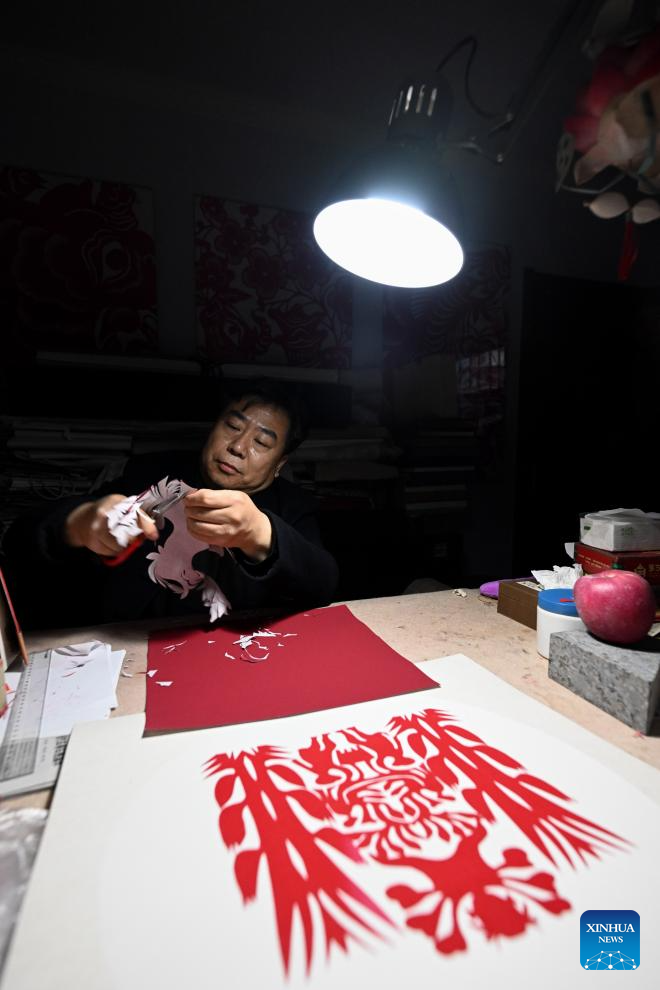
Duan Jianjun makes paper-cutting works at home in Horinger County, north China's Inner Mongolia Autonomous Region, March 14, 2024. The Horinger paper-cutting has formed a unique artistic style with rich patterns demonstrating animals, plants and folk customs, which is closely related to the geographical location of Horinger County, a place boasts a long history of both farming civilization and nomadic civilization. The craft was included in the national intangible cultural heritage list in 2008.(Xinhua/Bei He)
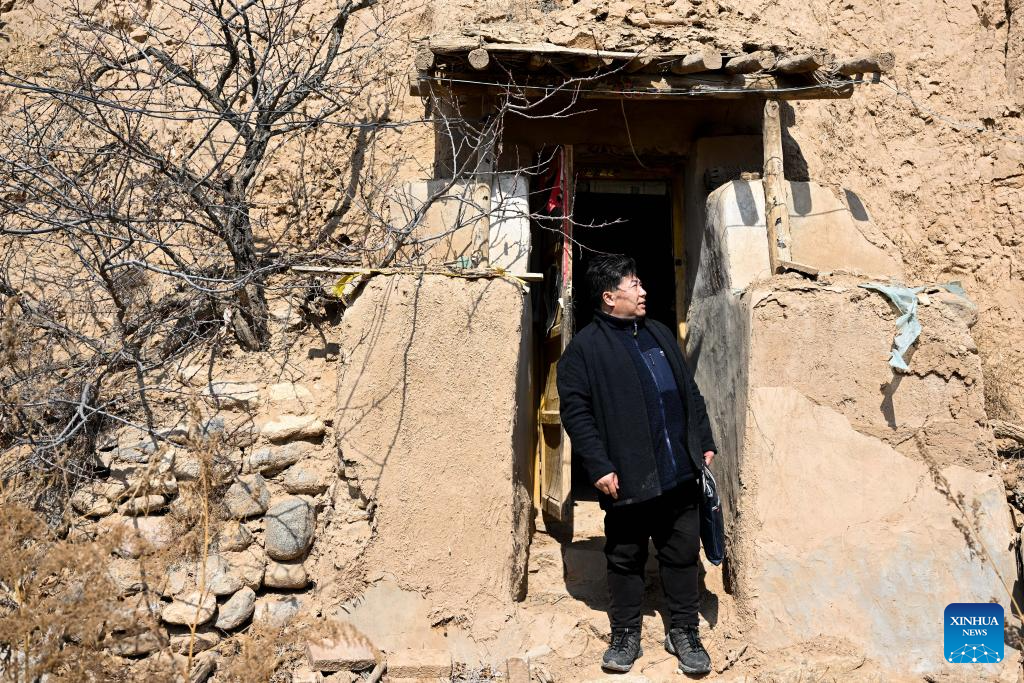
Duan Jianjun stands outside an old residence in Horinger County, north China's Inner Mongolia Autonomous Region, March 15, 2024. The Horinger paper-cutting has formed a unique artistic style with rich patterns demonstrating animals, plants and folk customs, which is closely related to the geographical location of Horinger County, a place boasts a long history of both farming civilization and nomadic civilization. The craft was included in the national intangible cultural heritage list in 2008.(Xinhua/Bei He)

Duan Jianjun (C) poses for a group photo with students of Horinger No. 2 Primary School in Horinger County, north China's Inner Mongolia Autonomous Region, March 14, 2024. The Horinger paper-cutting has formed a unique artistic style with rich patterns demonstrating animals, plants and folk customs, which is closely related to the geographical location of Horinger County, a place boasts a long history of both farming civilization and nomadic civilization. The craft was included in the national intangible cultural heritage list in 2008.(Xinhua/Liang Wanshan)
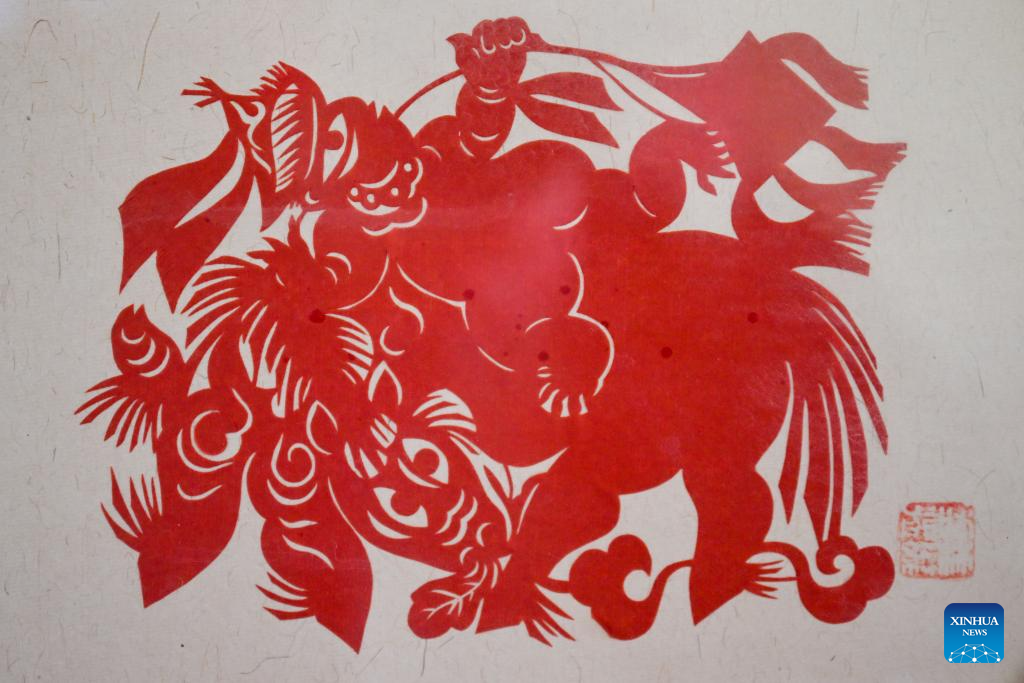
This photo taken on March 15, 2024 shows a paper-cutting work created by Duan Jianjun in Horinger County, north China's Inner Mongolia Autonomous Region. The Horinger paper-cutting has formed a unique artistic style with rich patterns demonstrating animals, plants and folk customs, which is closely related to the geographical location of Horinger County, a place boasts a long history of both farming civilization and nomadic civilization. The craft was included in the national intangible cultural heritage list in 2008.(Xinhua/Li Zhipeng)



